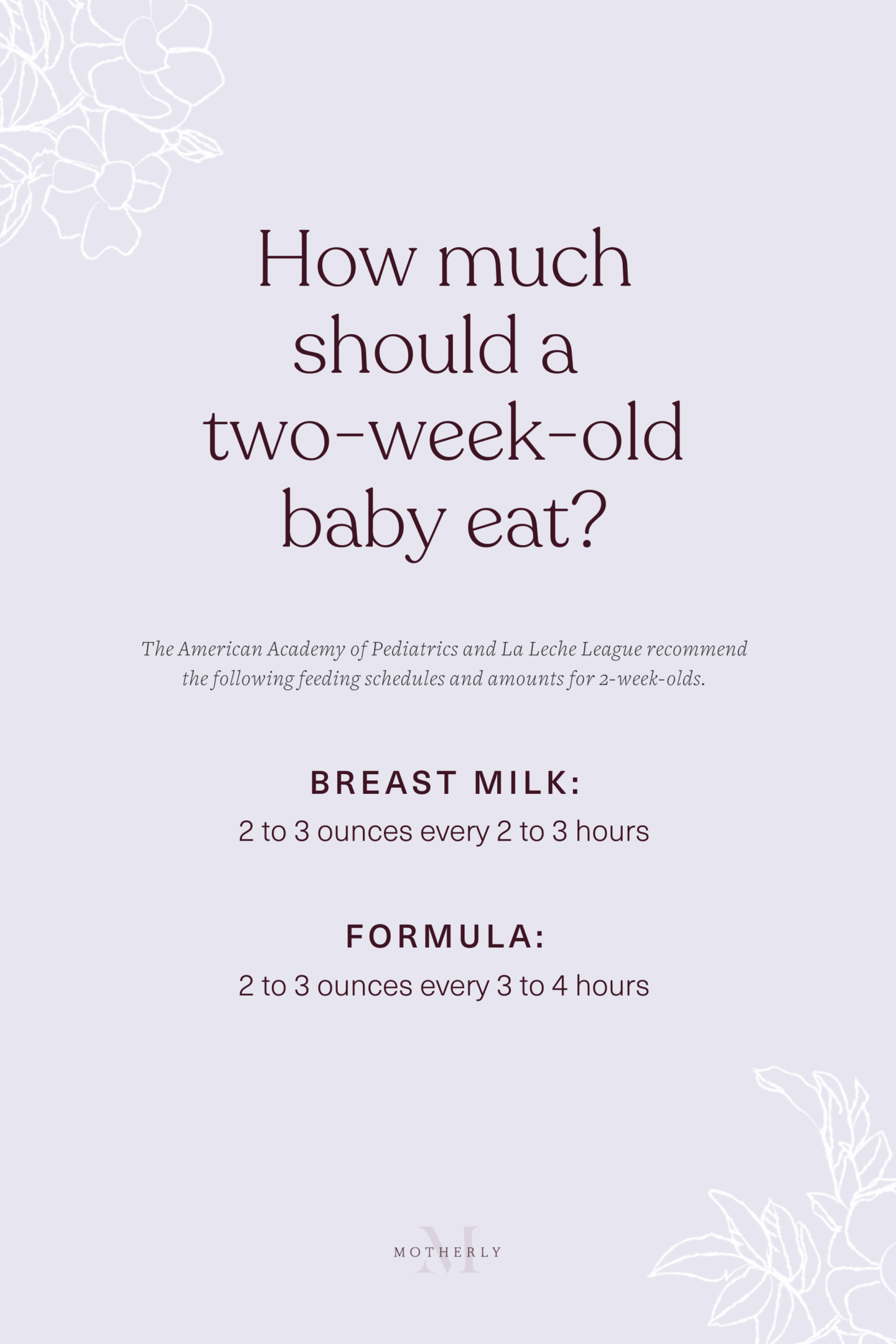2-week-old baby feeding schedule & amounts

Remember—feeding a newborn is a learned skill, and you're both doing great.
Table of Contents
Mama, when it comes to feeding your baby, practice makes perfect—and you’re already well on your way. It can feel like staying on top of your 2-week-old newborn’s feeding schedule is a part-time job regardless of whether you are breastfeeding your newborn, formula-feeding or doing a combination of the two. Just know that what may feel like work now will soon become second-nature to you both. Also keep in mind that fueling and hydrating yourself properly is important. Here’s a list of our favorite breastfeeding snacks—perfect for one-handed eating.
Related: 1-month-old baby milestones
How much should a 2-week-old baby eat?
The American Academy of Pediatrics and La Leche League recommend the following feeding schedules and amounts for 2-week-olds.
Breast milk: 2 to 3 ounces every 2 to 3 hours
Formula: 2 to 3 ounces every 3 to 4 hours
Note that because formula tends to be metabolized more slowly than breast milk (meaning it takes longer to digest and empty from the stomach), when using formula, your baby’s feeding windows may be a bit more spread out.
The American Academy of Pediatrics (AAP) also recommends that parents should follow the responsive feeding method, also known as feeding on demand, which looks to the infant’s hunger cues for when to feed. The schedules below are just examples—be sure to follow your baby’s hunger signals to know when your little one is ready for the next feeding. As babies get older, their hunger cues and feeding times start to become a little more predictable.
Related: Activities for a newborn

How often should a 2-week-old baby eat?

Remember, it’s more important that you follow your baby’s cues than adhere to a set schedule, so schedules outlined are general guides of how frequently you’ll feed your baby—not hard-and-fast rules.
These guidelines also apply primarily to infants born full-term and without any underlying medical conditions. For preterm infants, babies with certain medical conditions or for any specific questions pertaining to your child, be sure to consult your child’s pediatrician for a more customized feeding schedule.
Related: How much sleep does a 2-week-old need?
What are common 2-week-old baby hunger cues?
Recognizing your baby’s hunger cues is an early form of communication–and helps promote strong attachment your baby gives a sign, and you respond, meeting their need. Here’s what to look out for.
Gentle cues
Eyes moving beneath closed eyelids or eyelids fluttering when waking from sleep, moving their hands toward their mouth, licking their lips, sticking out their tongue or opening and closing their mouth
Stronger cues
Rooting (turning their head from side to side repeatedly), whimpering, sucking on hands
Obvious demands
Crying, tensing up, fussiness
Is my 2-week-old baby eating enough?
If you bottle-feed your baby, it is easier to evaluate how much milk or formula your baby is eating. Breastfeeding mamas will need to look at other signs that their 2-week-old. La Leche League suggests estimating your baby’s milk intake by looking at their diaper output: At 2 weeks, your breastfed baby should have at least two yellowish, loose stools and six or more wet diapers.
Related: This baby care log is so easy to use—even when you’re exhausted
A note from Motherly on feeding a 2-week-old
When you’re learning how to feed your newborn and your newborn is learning how to eat, there is a double-sided learning curve. Whether you are breastfeeding, formula feeding or combo-feeding your baby, lean on resources and ask for help. You don’t need to know it all now. You just need to learn as you go. Remember—feeding a newborn is a learned skill, and you’re both doing great.
Look ahead: 3-week-old baby feeding schedule and amounts
A version of this story was published December 13, 2021. It has been updated.





























